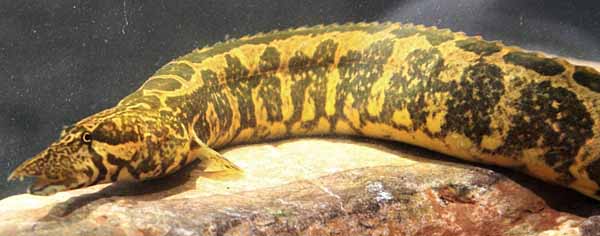Mastacembelus simack
(Walbaum, 1792)
|
Familie: Mastacembelidae SynonymeOphidium simack Walbaum, 1792
Rhynchobdella haleppensis Bloch & Schneider, 1801
Mastacembelus syriacus Gronow in Gray, 1854 Lokale Bezeichnung |
 Mastacembelus simack (Syrien, Dayr Az Zawr Provinz, Deir ez-Zor) -- (c) mnauky iNaturalist; BY-NC 4.0 |
Typen
Lectotypus: pl. 12 fig 2 in Russell (1756).
Siehe: Eschmeyer, W.N., Fricke, R. & Van der Laan, R. (eds.) 2024. Catalog of Fishes electronic version
Typusfundort: "Fluvio prope Halepum" [= am Fluss bei Aleppo = Coic [Queiq] River (Syrien)]. Basierend auf Gronovius (1762 u. 1763) und Russell (1756).
Etymologie
Simak ist die lokale Bezeichnung für diese Art in Syrien.
Verbreitung
Kleinasien und Naher Osten: Einzugsgebiete des Tigris, des Kor und des Persischen Golfs (Türkei, Syrien, Irak und Iran).
IUCN Status

EX Extinct (ausgestorben)
EW Extinct in the Wild (in der Natur ausgestorben)
CR Critically Endangered (vom Aussterben bedroht)EN Endangered (stark gefährdet)
VU Vulnerable (gefährdet)
NT Near Threatened (potenziell gefährdet)
LC Least Concern (nicht gefährdet)
RE Regionally Extinct (regional oder national ausgestorben)DD Data Deficient (ungenügende Datengrundlage)
NE Not Evaluated (nicht beurteilt)
Status: Stand 8.7.2022: NE Not Evaluated (nicht beurteilt)
Gefahren für diese Art: (nicht beurteilt)
Literatur
- Russell, A. 1756. The natural history of Aleppo, and parts adjacents. Containing a description of the city, and the principal natural productions in its neighbourhood; together with an account of the climate, inhabitants, and diseases particularly of the plague, with the methods used by the europeans for their preservation. Millar, London, viii + 266 + 10 pp., 16 pls. (BHL) Zitatseite [:75, pl. 12 fig. 2, als 'simak']
- Gronovius, L.T. 1763–1764. Zoophylacii Gronoviani fasciculus primus exhibens animalia quadrupeda, amphibia atque pisces, quae in museo suo adservat, rite examinavit, systematice disposuit, descripsit atque iconibus illustravit Laur. theod. Gronovius. Vol. 1 (1763) & Vol. 2 (1764). Sumptibus auctoris [veröffentlicht vom Autor], Lugduni Batavorum [Leiden], pp. 1–140, pls. 1–17 & pp. 141–236. (BHL) Zitatseite [:132 [n. 402], pl. 8a fig. 1a, als 'simak']
- Walbaum, J.J. 1792. Petri Artedi sueci genera piscium. In quibus systema totum ichthyologiae proponitur cum classibus, ordinibus, generum characteribus, specierum differentiis, observationibus plurimis. Redactis speciebus 242 ad genera 52. Ichthyologiae pars III. Ant. Ferdin. Rose, Grypeswaldiae [Greifswald]. Teil 3: [i-viii] + 1-723, Pls. 1-3. (PDF) Zitatseite [:159, !!, als Ophidium, Simack]
- Russell, A. & Russell, P. 1794. The natural history of Aleppo, containing a description of the city, and the principal natural productions in its neighbourhood. together with an account of the climate, inhabitants, and diseases; particularly of the plague. by Alex. Russell. the second edition. Revised, enlarged, and illustrated with notes. by, Pat. Russell. Vol. 2. Robinson, London, vii + 430 + xxxiv + 26 pp., pls. 1–16. (BHL) Zitatseite [:209, Pl. 6, Autor: P. Russell !!, als Ophidium mastacembelus]
- Gmelin 1797-1798. Russell, A. & Russell, P. (1797) Naturgeschichte von Aleppo, enthaltend eine beschreibung der Stadt, und der vornehmsten Naturerzeugnisse in ihrer Nachbarschaft, zugleich mit einer Nachricht von dem Himmelstriche, den Einhwohnern, und ihren Krankheiten, insbesondere der Pest. Von Alexander Russell. Zwote Ausgabe. Durchgesehen, vermehrt und mit Anmerkungen erläutert von Patrick Russell. Uebersezt, mit einigen Anmerkungen von Johann Friedrich Gmelin. Erster Band. 1 (1797). Rosenbusch, Göttingen, xxxii + 440 pp., 1 map. [1] Zitatseite [:99–102, als Ophidium Mastacembelus u. Mastacembalus]
- Bloch, M.E. & Schneider, J.G. 1801. M. E. Blochii, Systema Ichthyologiae Iconibus cx Ilustratum. Post obitum auctoris opus inchoatum absolvit, correxit, interpolavit Jo. Gottlob Schneider, Saxo. Berolini. Sumtibus Auctoris Impressum et Bibliopolio Sanderiano Commissum i–lx + 1–584, Pls. 1–110. (BHL) Zitatseite [:480, Autor: Bloch, !!, als Rhynchobdella haleppensis]
- Gray, J.E. 1854. Catalogue of fish collected and described by Laurence Theodore Gronow, now in the British Museum. London. i-vii + 1-196. (PDF) Zitatseite [: 172, Autor: Gronow, !!, als Mastacembelus syriacus]
- Günther, A. 1861. Catalogue of the fishes in the British Museum. Catalogue of the acanthopterygian fishes in the collection of the British Museum. Gobiidae, Discoboli, Pediculati, Blenniidae, Labyrinthici, Mugilidae, Notacanthi. London 3: i–xxv + 1–586 + i–x. (BHL) Zitatseite [:541, als Mastacembelus aleppensis (= ungerechtfertigte Korrektur von haleppensis]
- Wheeler, A. 1956. The type species of Mastacembelus and the second edition of Russell’s «Natural history of Aleppo». Raffles Bulletin of Zoology, 27: 91–92. (PDF)[:92, Ophidium simack als fraglich binomialer Name]
- Sufi, S.M.K. 1956. Revision of the Oriental fishes of the family Mastacembelidae. Bulletin of the Raffles Museum, #27: 93-146, Pls. 13-26. (PDF) Zitatseite [:111, Ophidium, Simack als kein binomialer Name]
- Coad, B.W. 1991. Fishes of the Tigris-Euphrates Basin: a critical checklist. Syllogeus, 68: 1-49. Zitatseite [:22, als Synonym von Mastacembelus mastacembelus]
- Mayland, H.J. 1991. Stachelaale. Jäger im Dämmerlicht. Das Aquarium, #261, (3): 6-11. Zitatseite [:7, gelistet, als Mastacembelus mastacembelus]
- Krupp, F. 1992. Die Karstquellen von Ra's Al-Ain - Eine Süßwasserlebensgemeinschaft in der Steppe Mesopotamiens. aqua geographia, 1 (1): 26-33. Zitatseite [:33, Farbfoto, Vorkommen, als Mastacembelus mastacembelus]
- Kottelat, M. & Lim, K.K.P. 1994 Diagnoses of two new genera and three new species of earthworm eels from the Malay peninsula and Borneo (Teleostei: Chaudhuriidae). Ichthyological Exploration of Freshwaters, 5 (2): 181-190. Zitatseite [:189, als Sinobdella haleppensis]
- Britz, R. 2020. Stachelaale aus Afrika und dem Mittleren Osten. Amazonas (Süßwasser-Aquaristik), #91, 16 (5): 20-23. Zitatseite [: 20*, Farbfoto, Übersichtsartikel, als Mastacembelus mastacembelus]
- Gholamhosseini, A., Razbanian, M., Esmaeili, H.R. & Eagderi, S. 2022. Molecular systematics and morphological variation in the Mesopotamian spiny eel Mastacembelus mastacembelus (Teleostei: Mastacembelidae). The European Zoological Journal, 89 (1): 546–555. (doi) Zitatseite [: als Mastacembelus mastacembelus]
- Kottelat, M. 2022. Mastacembelus simack, the valid name of the Mesopotamian spiny eel (Teleostei: Mastacembelidae). Zootaxa, 5162 (4): 446-450. (doi) Zitatseite [:496ff, Beschreibung, Re-Validierung, als Mastacembelus simack u. Ophidium, Simack als damals übliche Schreibweise und Akzeptanz als binomialer Name; Ophidium mastacembelus, Rhynchobdella haleppensis, Mastacembelus syriacus u. Mastacembelus aleppensis als Synonym]
